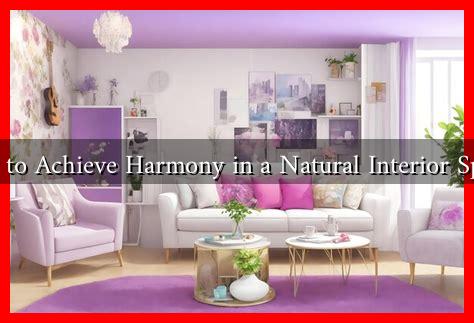-
Table of Contents
- How to Achieve Harmony in a Natural Interior Space
- Understanding Biophilic Design
- Key Elements of Biophilic Design
- Color Psychology in Interior Spaces
- Choosing the Right Color Palette
- Incorporating Sustainable Practices
- Tips for Sustainable Interior Design
- Creating a Balanced Layout
- Case Studies: Successful Natural Interiors
- Conclusion
How to Achieve Harmony in a Natural Interior Space
Creating a harmonious natural interior space is not just about aesthetics; it’s about fostering a sense of well-being and tranquility. As urban living becomes more prevalent, the need for a serene environment that reflects nature has gained importance. This article explores various strategies to achieve harmony in your interior spaces, drawing on principles of biophilic design, color psychology, and sustainable materials.
Understanding Biophilic Design
Biophilic design is an approach that seeks to connect people with nature through the built environment. It emphasizes the integration of natural elements into interior spaces, which can significantly enhance mood and productivity. According to a study by the University of Exeter, workplaces that incorporate natural elements can increase employee productivity by up to 15%.
Key Elements of Biophilic Design
- Natural Light: Maximize the use of natural light by incorporating large windows or skylights. This not only reduces energy consumption but also improves mood and well-being.
- Indoor Plants: Adding greenery can purify the air and create a calming atmosphere. Consider plants like snake plants or peace lilies, which are known for their air-purifying qualities.
- Natural Materials: Use materials such as wood, stone, and bamboo to create a tactile connection to nature. These materials can add warmth and texture to your space.
Color Psychology in Interior Spaces
The colors you choose for your interior can significantly impact your mood and perception of space. Color psychology suggests that different colors evoke different feelings and responses. For instance, greens and blues are often associated with tranquility and calmness, while yellows can evoke happiness and energy.
Choosing the Right Color Palette
- Earthy Tones: Shades of brown, beige, and green can create a grounded and serene environment.
- Soft Blues and Greens: These colors can mimic the sky and water, promoting relaxation and peace.
- Accent Colors: Use brighter colors sparingly as accents to energize the space without overwhelming it.
Incorporating Sustainable Practices
In today’s world, sustainability is more than just a trend; it’s a necessity. Incorporating sustainable practices into your interior design not only benefits the environment but also contributes to a sense of harmony and well-being.
Tips for Sustainable Interior Design
- Use Recycled Materials: Opt for furniture and decor made from recycled or upcycled materials to reduce waste.
- Choose Eco-Friendly Paints: Select low-VOC (volatile organic compounds) paints to improve indoor air quality.
- Energy-Efficient Lighting: Replace traditional bulbs with LED lighting to save energy and reduce your carbon footprint.
Creating a Balanced Layout
A harmonious interior space also requires a thoughtful layout. The arrangement of furniture and decor can influence the flow and energy of a room. Here are some tips for achieving balance:
- Focal Points: Create a focal point in each room, such as a piece of art or a fireplace, to draw the eye and create interest.
- Flow and Movement: Ensure there is enough space for movement. Avoid overcrowding furniture, which can create a chaotic atmosphere.
- Symmetry and Asymmetry: Use a mix of symmetrical and asymmetrical arrangements to create visual interest while maintaining balance.
Case Studies: Successful Natural Interiors
Several companies and designers have successfully implemented these principles in their projects. For example, the Google office in Zurich features extensive use of natural light, indoor gardens, and sustainable materials, resulting in a workspace that promotes creativity and well-being. Similarly, the Eden Project in the UK showcases how biophilic design can be integrated into large-scale architecture, creating a harmonious environment that educates visitors about sustainability.
Conclusion
Achieving harmony in a natural interior space involves a thoughtful blend of biophilic design, color psychology, sustainable practices, and balanced layouts. By incorporating these elements, you can create an environment that not only looks beautiful but also enhances your well-being. Remember, the goal is to create a space that resonates with nature, promotes tranquility, and fosters a sense of connection to the world around you. For more insights on sustainable design, visit Sustainable Furnishings Council.


